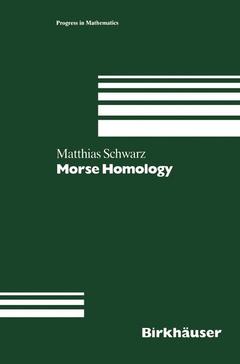Description
Morse Homology, Softcover reprint of the original 1st ed. 1993
Progress in Mathematics Series, Vol. 111
Author: Schwarz
Language: English
Subjects for Morse Homology:
Publication date: 10-2012
236 p. · 15.5x23.5 cm · Paperback
236 p. · 15.5x23.5 cm · Paperback
Description
/li>Contents
/li>
1.1 Background The subject of this book is Morse homology as a combination of relative Morse theory and Conley's continuation principle. The latter will be useda s an instrument to express the homology encoded in a Morse complex associated to a fixed Morse function independent of this function. Originally, this type of Morse-theoretical tool was developed by Andreas Floer in order to find a proof of the famous Arnold conjecture, whereas classical Morse theory turned out to fail in the infinite-dimensional setting. In this framework, the homological variant of Morse theory is also known as Floer homology. This kind of homology theory is the central topic of this book. But first, it seems worthwhile to outline the standard Morse theory. 1.1.1 Classical Morse Theory The fact that Morse theory can be formulated in a homological way is by no means a new idea. The reader is referred to the excellent survey paper by Raoul Bott [Bol.
1 Introduction.- 1.1 Background.- 1.2 Overview.- 1.3 Remarks on the Methods.- 1.4 Table of Contents.- 1.5 Acknowledgments.- 2 The Trajectory Spaces.- 2.1 The Construction of the Trajectory Spaces.- 2.2 Fredholm Theory.- 2.3 Transversality.- 2.4 Compactness.- 2.5 Gluing.- 3 Orientation.- 3.1 Orientation and Gluing in the Trivial Case.- 3.2 Coherent Orientation.- 4 Morse Homology Theory.- 4.1 The Main Theorems of Morse Homology.- 4.2 The Eilenberg-Steenrod Axioms.- 4.3 The Uniqueness Result.- 5 Extensions.- 5.1 Morse Cohomology.- 5.2 Poincaré Duality.- 5.3 Products.- A Curve Spaces and Banach Bundles.- B The Geometric Boundary Operator.
© 2024 LAVOISIER S.A.S.
These books may interest you

Morse TheorySmooth and Discrete 60.42 €

Selected Papers 68.56 €

Morse Theory for Hamiltonian Systems 214.69 €

